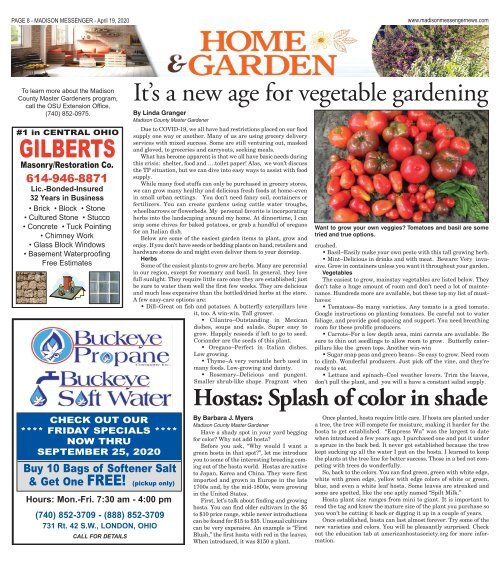Madison Messenger - April 19th, 2020
Create successful ePaper yourself
Turn your PDF publications into a flip-book with our unique Google optimized e-Paper software.
PAGE 8 - MADISON MESSENGER - <strong>April</strong> 19, <strong>2020</strong><br />
www.madisonmessengernews.com<br />
To learn more about the <strong>Madison</strong><br />
County Master Gardeners program,<br />
call the OSU Extension Office,<br />
(740) 852-0975.<br />
#1 in CENTRAL OHIO<br />
GILBERTS<br />
Masonry/Restoration Co.<br />
614-946-8871<br />
Lic.-Bonded-Insured<br />
32 Years in Business<br />
• Brick • Block • Stone<br />
• Cultured Stone • Stucco<br />
• Concrete • Tuck Pointing<br />
• Chimney Work<br />
• Glass Block Windows<br />
• Basement Waterproofing<br />
Free Estimates<br />
By Linda Granger<br />
<strong>Madison</strong> County Master Gardener<br />
CHECK OUT OUR<br />
**** FRIDAY SPECIALS ****<br />
NOW THRU<br />
SEPTEMBER 25, <strong>2020</strong><br />
Buy 10 Bags of Softener Salt<br />
& Get One FREE! (pickup only)<br />
Hours: Mon.-Fri. 7:30 am - 4:00 pm<br />
(740) 852-3709 - (888) 852-3709<br />
731 Rt. 42 S.W., LONDON, OHIO<br />
CALL FOR DETAILS<br />
It’s a new age for vegetable gardening<br />
Due to COVID-19, we all have had restrictions placed on our food<br />
supply one way or another. Many of us are using grocery delivery<br />
services with mixed success. Some are still venturing out, masked<br />
and gloved, to groceries and carryouts, seeking meals.<br />
What has become apparent is that we all have basic needs during<br />
this crisis: shelter, food and ….toilet paper! Alas, we won’t discuss<br />
the TP situation, but we can dive into easy ways to assist with food<br />
supply.<br />
While many food stuffs can only be purchased in grocery stores,<br />
we can grow many healthy and delicious fresh foods at home—even<br />
in small urban settings. You don’t need fancy soil, containers or<br />
fertilizers. You can create gardens using cattle water troughs,<br />
wheelbarrows or flowerbeds. My personal favorite is incorporating<br />
herbs into the landscaping around my home. At dinnertime, I can<br />
snip some chives for baked potatoes, or grab a handful of oregano<br />
for an Italian dish.<br />
Below are some of the easiest garden items to plant, grow and<br />
enjoy. If you don’t have seeds or bedding plants on hand, retailers and<br />
hardware stores do and might even deliver them to your doorstep.<br />
Herbs<br />
Some of the easiest plants to grow are herbs. Many are perennial<br />
in our region, except for rosemary and basil. In general, they love<br />
full sunlight. They require little care once they are established; just<br />
be sure to water them well the first few weeks. They are delicious<br />
and much less expensive than the bottled/dried herbs at the store.<br />
A few easy-care options are:<br />
• Dill—Great on fish and potatoes. A butterfly caterpillars love<br />
it, too. A win-win. Tall grower.<br />
• Cilantro—Outstanding in Mexican<br />
dishes, soups and salads. Super easy to<br />
grow. Happily reseeds if left to go to seed.<br />
Coriander are the seeds of this plant.<br />
• Oregano—Perfect in Italian dishes.<br />
Low growing.<br />
• Thyme—A very versatile herb used in<br />
many foods. Low-growing and dainty.<br />
• Rosemary—Delicious and pungent.<br />
Smaller shrub-like shape. Fragrant when<br />
Want to grow your own veggies? Tomatoes and basil are some<br />
tried and true options.<br />
crushed.<br />
• Basil—Easily make your own pesto with this tall growing herb.<br />
• Mint—Delicious in drinks and with meat. Beware: Very invasive.<br />
Grow in containers unless you want it throughout your garden.<br />
Vegetables<br />
The easiest to grow, mainstay vegetables are listed below. They<br />
don’t take a huge amount of room and don’t need a lot of maintenance.<br />
Hundreds more are available, but these top my list of musthaves:<br />
• Tomatoes—So many varieties. Any tomato is a good tomato.<br />
Google instructions on planting tomatoes. Be careful not to water<br />
foliage, and provide good spacing and support. You need breathing<br />
room for these prolific producers.<br />
• Carrots—For a low depth area, mini carrots are available. Be<br />
sure to thin out seedlings to allow room to grow. Butterfly caterpillars<br />
like the green tops. Another win-win<br />
• Sugar snap peas and green beans— So easy to grow. Need room<br />
to climb. Wonderful producers. Just pick off the vine, and they’re<br />
ready to eat.<br />
• Lettuce and spinach—Cool weather lovers. Trim the leaves,<br />
don’t pull the plant, and you will a have a constant salad supply.<br />
Hostas: Splash of color in shade<br />
By Barbara J. Myers<br />
<strong>Madison</strong> County Master Gardener<br />
Have a shady spot in your yard begging<br />
for color? Why not add hosta?<br />
Before you ask, “Why would I want a<br />
green hosta in that spot?”, let me introduce<br />
you to some of the interesting breeding coming<br />
out of the hosta world. Hostas are native<br />
to Japan, Korea and China. They were first<br />
imported and grown in Europe in the late<br />
1700s and, by the mid-1800s, were growing<br />
in the United States.<br />
First, let’s talk about finding and growing<br />
hosta. You can find older cultivars in the $5<br />
to $10 price range, while newer introductions<br />
can be found for $15 to $35. Unusual cultivars<br />
can be very expensive. An example is “First<br />
Blush,” the first hosta with red in the leaves.<br />
When introduced, it was $150 a plant.<br />
Once planted, hosta require little care. If hosta are planted under<br />
a tree, the tree will compete for moisture, making it harder for the<br />
hosta to get established. “Empress Wu” was the largest to date<br />
when introduced a few years ago. I purchased one and put it under<br />
a spruce in the back bed. It never got established because the tree<br />
kept sucking up all the water I put on the hosta. I learned to keep<br />
the plants at the tree line for better success. Those in a bed not competing<br />
with trees do wonderfully.<br />
So, back to the colors. You can find green, green with white edge,<br />
white with green edge, yellow with edge colors of white or green,<br />
blue, and even a white leaf hosta. Some leaves are streaked and<br />
some are spotted, like the one aptly named “Spilt Milk.”<br />
Hosta plant size ranges from mini to giant. It is important to<br />
read the tag and know the mature size of the plant you purchase so<br />
you won’t be cutting it back or digging it up in a couple of years.<br />
Once established, hosta can last almost forever. Try some of the<br />
new varieties and colors. You will be pleasantly surprised. Check<br />
out the education tab at americanhostasociety.org for more information.


















